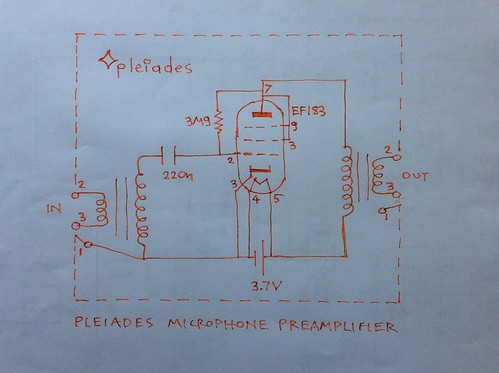Small current or voltage variations are given by the mic anyway for speech level singing.
On the other hand, the last stage, a power amplifier may need more voltage and current. Sometimes this can be relatively low too. See for example the Pleiades 2N3053 power amplifier at 8mA quiescent current driving a sensitive Philips speaker.
Nevertheless higher plate potentials than 1.2V will be supplied to the 2DV4 electron tube as mic booster amplifier to see what happens.
(Attention: Any electric potential or voltage can be dangerous. Also batteries or other sources of potential must be connected in series with a suitable fuse for safety).
The 2DV4 will be further tested today at say 12V, 24V plate potential and grid at space potential.
Referring to the Pleiades V6 schematic with Cc=22nF, Vh=1.3V

Signal path:
male singing voice - Sennheiser MD mic - Pleiades V6 2DV4, Altec 4722 input transformer - Sony TC-D5 Pro mic in phase inverted for correct overall phase - Sennheiser HD580
When Vb=12V, Ia is about 7μA, (grid at space potential).
Great sound with MD441 at 12in
Great sound with MD211 at 2in. Much louder since the mic can be approached as there is no proximity effect on omni mics.
Experiment in progress...
24V connected to plate or anode through the output transformer. Ia jumps to more than 100μA.
Interesting. Hiss almost disappears. It disappears especially if nothing is connected to the XLR mic in and the amp appears to be in very low gain. Just a peaky mid noise is heard.
Then when the MD441 mic is connected it sounds like a blast of ambience. Scary.
The vocal sound though is not very interesting. Bass heavy in a bad sense. And somehow mid peaky.
Better but on the same line is behaviour with the MD211.
MD441 U3 is taken outdoors, together with headphones. The Sony limiter is switched on. So room LF modes are out. But the sound is still bass heavy and peaky. It is interesting how the MD441 now directionally discriminates at free field. Various groups of insects or birds can be discriminated according to where the mic is pointing. City neighbour air conditioning noise etc very apparent too.
Back to indoors. Suspecting input transformer secondary reasonance, so about 680KΩ resistor is connected in parallel with it. A little difference. Some mid part is removed from singing voice too. Not sure which sounds best.
An 100KΩ one will be tried.
Experiment in progress....
100KΩ reduces substantially input to the electron tube. Sound not nice or interesting.
Ia is dropping as 1.2V battery supplying heaters is being discharged. Asking the help of positive cathode. A 1.9MΩ is connected from grid to cathode, so little pull up bias. Ia becomes 20μA. Some bass heaviness. Replacing battery. Back to open grid. At Vb=12V Ia increases from 4μA to 7μΑ. Sound is nice as previously described buy leave something to be desired.
Vb now changed to 24V. Ia for open grid (grid at space potential) becomes 80μA.
Sound bass heavy for MD441 even outdoors. Sound much less bass heavy for MD211 but still not quite right. Another reason for all these may be the output transformer saturating from higher Ia DC current.
And now back to Vb=1.2V. Pull up bias with 1.9MΩ from anode to control grid. Little Ia , 2-3μA? Amazing sound. Very full but not bass heavy on MD441 at 4-6in. No mid peaky artifacts. Great sound on MD211, less body since proximity effect is already compensated by output transformer and high electron tube plate resistance since Ia is low. But great and bright sound too and perhaps enough body when used at 2in.
Conclusion. It happened almost by chance and following 2 dreams. It was never expected that 1.2V at the anode on the 2DV4 would outperform much more sensible anode currents. On Pleiades experiments it is the first time that the MD441 U3 sounds at all its pristine glory and world class sound. The fullness and detail reminds When I Fall in Love - Nat King Cole classic. Could it be that the Fall in Love brilliant sound engineer John F. Kraus was experimenting a lot with electron tubes? He was an important radio ham too.
http://articles.latimes.com/1996-12-05/news/mn-6038_1_recording-engineer
What happens if the Pleiades V6 is disconnecte and the MD441 U3 directly connected to Sony TC-D5 Pro?
Output decreases and becomes very bass heavy. Sony Rec level must go to 10/10. Hiss gets in. If a Pleiades R,L filter is connected after the mic, bass heaviness disapears. The sound becomes too bass or treble extended. Somewhat hyped. Back to inserting the Pleiades V6 with 2DV4 at Vh, Vb 1.2V. Big natural sound with presence, not disturbing bass body and great treble detail. The 30ft away clock can be heard through headphones through the hiss and ambience when rec level is increased.
How would Pleiades V6 2DV4 sound like connected to Uher 4200?
No comments:
Post a Comment